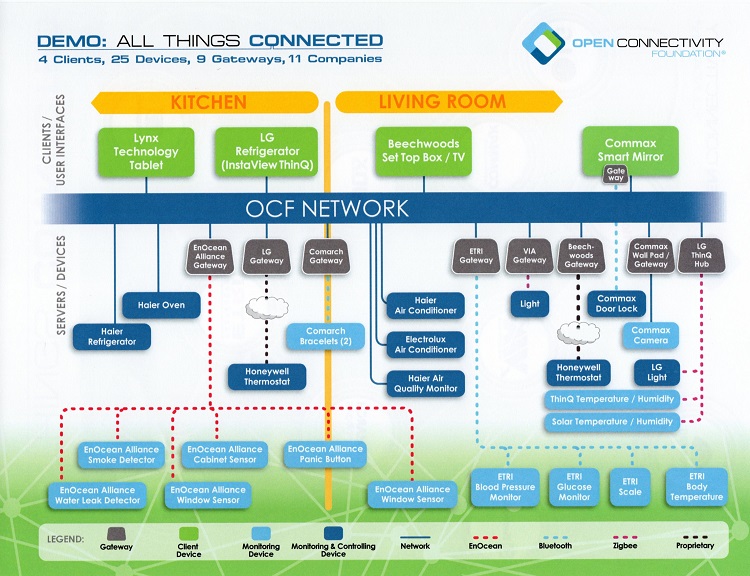By Richard Quinnell, editor-in-chief
At the recent CES 2018, the Internet of Things (IoT) was on full display, with dedicated areas for IoT infrastructure, smart cities, home automation, and more. And it’s no wonder. According to the Consumer Technology Association’s industry forecast, smart home products will represent a $4.5 billion industry in 2018, with smart speakers like Amazon’s Echo representing an additional $3.8 billion in revenue. But the IoT currently remains fragmented, especially in the home automation space, isolated by incompatible wireless networks and communications protocols. That is poised to change, however, and the dream of universal connectivity and interactivity about to be realized.
The first inklings came with the pre-show announcements by consumer industry giants of smart televisions that would serve as one hub of comprehensive home automation networks open to third-party devices for seamless integration. Samsung North America’s CEO, Tim Baxter, noted in his presentation, for instance, that more than 90% of Samsung’s consumer devices — televisions, refrigerators, ovens, washers, dryers, and the like — are now IoT-ready. Furthermore, all of their consumer products will have IoT built in and AI support by 2020 and be able to interact with one another and third-party products using the open SmartThings platform Samsung acquired in 2014. Already, said Baxter, Samsung sells a half-billion connected consumer devices each year.
LG Electronics made similar announcements later that same day. According to CTO I. P. Park, all of LG’s consumer products are now Wi-Fi enabled and IoT-ready. The company’s strategy calls for home IoT to have three key characteristics, said Park. First, the devices will evolve over time. Using AI such as the company’s ThinQ, consumer IoT will learn user habits and preferences and react accordingly. Second, the IoT will be in a wide variety of everyday products for the home, car, and office and will talk to one another. Third, the system will be open. “The world is too complex for a proprietary, closed solution,” said Park in his presentation.

The OCF demonstrated that it now has a specification that allows diverse home automation products to interoperate, realizing the original dream for the IoT. Image: OCF.
Having devices operate in an open ecosystem that allows them to readily interact has long been part of the industry’s vision for the IoT. But various efforts at implementing that vision resulted instead in market fragmentation. Wi-Fi proved too power-hungry to serve as the backbone; small IoT devices needed a different approach. Protocols such as ZigBee, Thread, Bluetooth, EnOcean, and others rose to fill the need but did not work from a common basis. The resulting IoT devices could not work together across protocols, forcing early developers and end users alike to pick the protocol that they thought might ultimately become a de facto standard. This uncertainty restricted acceptance and growth of home automation IoT.
The announcements at CES, however, suggest that the days of IoT fragmentation are limited. Major consumer product companies are promising open systems for home automation networks and implementing hubs that can bridge differing protocols and connectivity choices, allowing third-party devices to work within their systems as readily as their own devices. While this may still seem like two different (and incompatible) systems contending for the same market, there is one more point to consider.
Both Samsung and LG are high-ranking (Diamond) members of the Open Connectivity Forum (OCF), which currently boasts more than 400 member companies and which includes more than 80% of appliance companies. OCF itself is a merger of competing interoperability standards bodies now working to develop a common ground. The OCF is trying to create a software layer that lies above the transport layer for internet connectivity to allow devices using different protocols to communicate with one another. The logical structure uses a client/server approach, and through the use of gateways that comply to OCF standards, devices will be able to interoperate. Both device-to-user and device-to-device interactions are supported, giving the user a single app with which to control all devices and allowing devices to interact via a shared artificial intelligence.
In December 2017, the OCF took a major step forward in realizing the IoT dream by releasing its OCF Specification 1.3. This new specification addresses key security issues along with interoperability and sets the stage for developers to start bridging the gaps. The OCF also has a certification program to verify compliance with OCF 1.3, meaning that consumers need only look for compliant products and no longer worry about which protocol or wireless network the device specifically uses. Users will be free to mix and match devices based on function, price, and aesthetics rather than technology.
At CES, the OCF was demonstrating this approach in operation. Their smart home booth included 25 devices from 11 companies all working together using the OCF network. Individual devices, however, might use Bluetooth, ZigBee, EnOcean, or proprietary connections. The gateways provided the translations needed to use the common OCF network. The LG ThinQ network was part of the demonstration, with a refrigerator serving as the LG gateway to the OCF.
Marketing program manager for next-generation standards Kimberly Lewis of Intel, representing OCF at the show, indicated that the release of OCF 1.3 is likely to trigger an explosion of new, interoperable home automation IoT devices in the coming year. “We’re expecting a hockey stick of certifications,” Lewis told EP at CES. If realized, this surge in interoperable home automation IoT devices should finally start bringing the IoT out of the realm of mostly hype and plant it squarely at the start of fully realizing the IoT dream.
Advertisement
Learn more about Electronic Products Magazine





